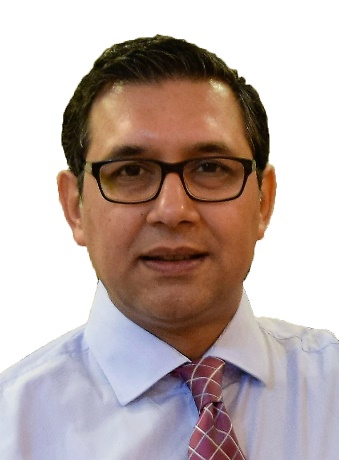 Mohammad Sajjad Moghal
Mohammad Sajjad Moghal
Chief Executive Officer
Classic International Trading (CIT)
Public Policy Program (’05)
Winner of the First GRIPS SDGs Award
Please tell us about your career path so far. What is your area of specialization and how did you come to work in this area?
I started my career as a banker in 1996. My last assignment in the bank was at the credit and foreign exchange department overlooking a credit portfolio of USD40 million of various corporate and non-corporate clients. I was also able to introduce some innovative credit concepts such as asset-backed big ticket securitization transactions for financing large infrastructure development projects, including power generation, roads, communication and ports. I also worked for Unilever Pakistan as Commercial Manager for a year before joining the Small & Medium Enterprise Development Authority (SMEDA), Government of Pakistan in 2002.
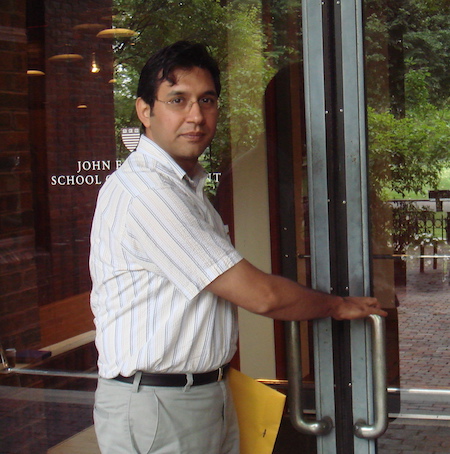
Sajjad at Kennedy School, Harvard University
At SMEDA, I spearheaded efforts for the country’s first National SME Policy by drafting the issues paper in 2004. As a result of my work, the National SME Policy was adopted in 2007 by the Government of Pakistan. This policy work also influenced the banking regulations and SME-focused banking policy and regulations were adopted by the central bank in 2006. Following these efforts, I developed a multi-year plan for SMEDA and secured US$27 Million SME sector development program funding from the Government of Pakistan. I had served as the lead technical person for the IFC’s Cost of Doing Business Study and the World Bank’s Investment Climate Assessment-II.
In 2008, I joined the United States Agency for International Development, Pakistan Mission as the team leader for the Private Sector Development (PSD). My first assignment was to design and deliver the US$250 million “USAID Empowering Pakistan” SME-focused Economic Growth portfolio under the Kerry-Lugar-Berman Act of 2009. To date, this remains to be the largest Economic Growth portfolio under the USAID umbrella, and has been praised and recognized for its design quality and the results it delivered during the course of implementation.
In 2010, I was elevated to the position of Senior Development Adviser for Multi-sector. I started overseeing a portfolio of projects covering economic growth, education, energy and health. I won several awards during my stint at USAID in recognition of my contributions. The list of accomplishments is long, below list though gives you a glimpse:
- Designed and managed USAID US$ 26 million Public-Private Partnership “the Dairy Project”, benefitting 50,000 small dairy holders, creating additional 9,000 jobs providing innovative extension services to farmers in 50,000 villages in Pakistan.
- Designed and completed two financing projects to provide $235 million in debt financing to SME through five local partner banks, in partnership with Credit Authority (DCA), USAID. This financing will fund business growth and clean energy projects.
- Designed and managed US$15 million Regional Agriculture Business Enabling Environment project focused on regulatory reforms attracting US$150 million in private sector investment.
- Established USAID regional office in the Punjab; recruited and mentored a team now managing a project portfolio of US$150 million across energy, agriculture, health and education sectors.
You are currently Chief Executive Officer of Classic International Trading, based in Lahore. Please tell us more about this company and your main roles and responsibilities?
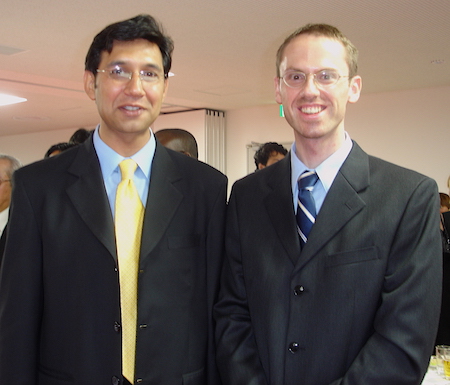
With his advisor Prof. Wade Pfau on Graduation Day at GRIPS, September 2005
Classic International Trading (CIT) is a B2B industrial chemicals supplier and the supply chain solution provider. The firm’s phenomenal growth in the past four years, earned us a central stage in industrial chemical supply business. CIT is the market leader in selling titanium dioxide (TiO2), Calcined Kaolin, and polyester resins in Pakistan. CIT represents nearly a dozen world renowned manufacturers such as UBE, Japan, Union Colours, the UK; Ad-Additives, the Netherlands; EGE KiMYA, Turkey; PennWhite, the UK; Shandon Jinhai, China; Shanxi Bright, China; Yantai Fenglin Advanced Materials, China and Lamirsa, Spain with a very diverse client based stretching across Paint & Coatings, Pharmaceutical, Ink, Master Batch for plastics, Agro-processing, Paper, Leather and Personal Care Industries.
CIT provides material, technology, ICT based ERP systems, and quality control support. In less than four years, the annual turnover of the firm exceeded PKR 500 million under my leadership, and successfully added another US$14 million commission-based business. The firm with a portfolio of 150 top notch clients, including DIC Ink, AkzoNobel, Kansai, Berger, ATS, Nippon to name a few, is the fastest growing in the segment. CIT is modeled on result-oriented management, and thrives on practical use of ICT.
My job at Classic International Trading is to provide strategic leadership to the firm, create value for the investors, employees, business partners, customers and the community. It is my entrepreneurial undertaking too, and I own fifty percent stake in the firm.
Classic International Trading is very unique under my watch; two and half percent of the firm’s net current assets is directly contributed to philanthropic initiatives annually. All income from selling waste packaging is also added to this pool.
CIT is the major contributor in providing free education to over 750 poor children who cannot afford formal school education without our assistance. CIT also provides assistance to buy medical care to deserving poor, and provides seed capital to micro-entrepreneurs.
In your current capacity, what do you see as the main opportunities and challenges for Pakistan over the course of the next five to ten years?
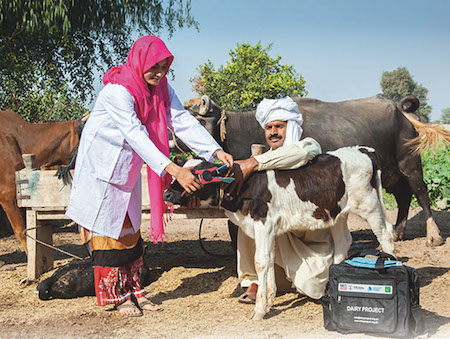
Female extension worker at work
Pakistan is going through a difficult phase in its history as it is caught between unrest in Afghanistan and violent rightist movement in India. The war in Afghanistan had its spillover effect; it cost the Pakistan economy roughly USD120 billion in the past 10 years and the country lost 22,000 Pakistanis to the war. The interest of the bilateral and multilateral donor community is waning, lately. By 2017, over 60% of international funding and development support ceased to exist after the U.S. elections in 2016 and subsequent change in the U.S. Policy.
Despite all these adversaries, Pakistan’s economy continued to grow at a modest rate of around 3%, and the private sector continued to provide 2.5% of GDP in philanthropy. This combination has filled the public social service gap in the country and continued to avoid any large-scale social unrest. We have seen foreign direct investment surge in the large infrastructure development lately, primarily through China Pakistan Economic Corridor (CPEC). These investments are likely to connect more intimately with the regional economies, and create necessary road, power, and port infrastructure to serve as the connectivity and services hub. Nonetheless, in the short term these investments are creating jobs, providing fresh impetus to growth and creating missing infrastructure to support long-term growth. In the next 5-10 years, I see that Pakistan will be integrated in the international manufacturing supply chain, and will become a connectivity hub for the central Asian economies through its services sector integration. It will gain more export markets in the EU and the USA. If Afghan peace talks come to fruition, Pakistan will be the largest beneficiary. In sum, in my personal opinion, the medium to long-term socio-economic outlook of Pakistan is positive.
What are some of the biggest challenges you face in your work? And what have been the most interesting or rewarding aspects of your career thus far?
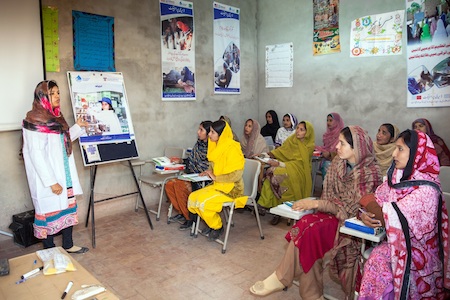
A training session for female extension workers
My greatest challenge of working in Pakistan has been the financial constraints. Pakistan has been struggling to manage the fiscal space to match or mimic the growth pattern of other regional economies such as India, Bangladesh, or China. Nevertheless, I have been extremely lucky to able to mobilize resources and muster support from a variety of resource contributors including bilateral donors and the local private sector. I have shared above some of my work, all done in Pakistan with support from a range of partners.
My policy work for SMEs has changed the life of millions of Pakistanis, after the passage of the policy and regulations. Today, a young entrepreneur can think about starting his own business and start contributing to the economic development of the country. My latest work in the dairy sector has completely changed the dairy landscape in the country in the past 5 years. Dairy has been the fastest growing sub-sector within agriculture and contributes around 12% GDP besides being the largest employer in the economy. Even at the subsistence level, it provides food security to a poor family, and there are millions of households in Pakistan. I take pride that whoever we were able to support directly or indirectly, we changed their lives for good. They were able to increase their family incomes by 10% i.e., USD60, feed their kids and even send them to school. Nothing is more rewarding than this comfort that changes that I triggered have profound positive effects on the lives of millions and it is sustained.
You have been selected as winner of the First GRIPS SDGs Award for your contribution to the “USAID-DRDF Dairy Project”. Please tell us more about this project and your role it in.
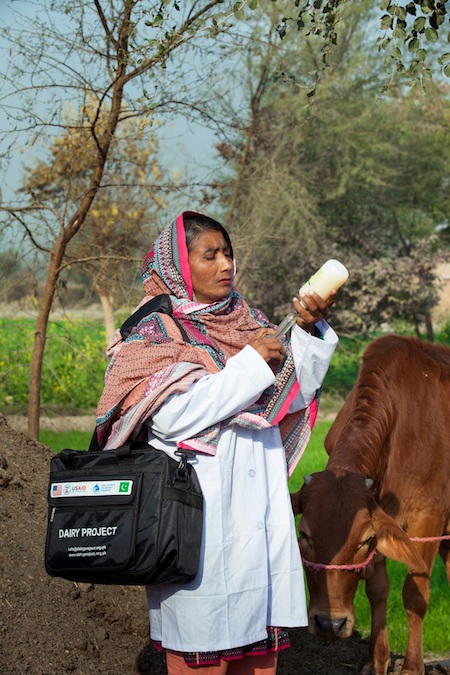
Female extension worker doing her job
In 2011, while working for USAID, I was asked to design and implement a project, potentially a public-private partnership that would help small dairy holders and improve the entire value chain. The development rationale behind the approach was that if we increase the per animal milk yield it will create additional incomes for farmers, will reduce cost for the milk processors such as Nestle, and will add jobs to the economy. All this will reduce vulnerability of communities to extremism and violence. The successful design of the project resulted in securing US$26 million funding from USAID and Nestle Pakistan.
We knew that the dairy and livestock sector contributes US$29 billion, or 12 percent to the national GDP and is growing at a modest rate of 3 percent per annum against the demand growth of 7 percent. Most of the dairy farms (roughly 5 million) in Pakistan are small housing five to seven low yielding lactating animals and managed primarily by women. Farm gate price of milk was 30 percent higher than the world average. Still, the demand in Pakistan outstrips supply by 0.8 billion liters, resulting in US$120 million spent annually to import dry milk for mixing with regular milk to augment the supply.
The Dairy Project was designed as the Public-Private Partnership between USAID and Nestle Pakistan to improve the economic lives of Pakistani small dairy holders who were stuck in subsistence farming and were unable to break the nexus of perpetuating poverty. For the purpose, a home-grown solution, and a local implementing partner was engaged to take on the task on hand.
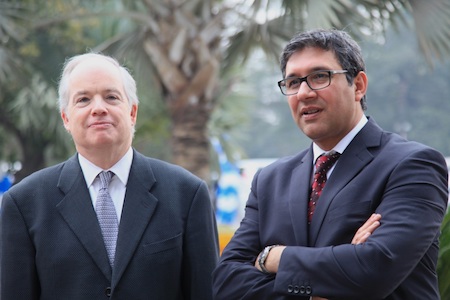
Sajjad with USAID Mission Director
The Dairy Project chose Dairy and Rural Development Foundation (DRDF), a local not for profit entity, as its implementation partner. The project over the next five years expanded its outreach to nearly 50,000 smallholder dairy farmers, and initially focused on teaching best practices in dairy production while adopting the value chain approach. It was equally important at the same time that unemployed local youth (boys and girls) were integrated into the dairy supply chain, as extension service providers. More specifically, these extension service providers would provide artificial insemination, feeding & fodder, curative and preventive health services alongside securing contracts with large milk processors for the sales of milk to ensure stable cash flow and incomes.
In the first phase, small dairy holders were taught skills on how to improve milk yields and manage their cattle stock. In the second phase, farmers were given access to cost share grants, and microfinance to improve their sheds, create cold chains for storage, buy farm equipment and to pay for the extension services such as artificial insemination, fodder, silage, curative and preventive healthcare.
In order for the extension services market to take off on a commercial basis, 6,000 moderately educated unemployed rural women were trained, to provide supplies and services related to health and feed. Likewise, another 2,500 young men were trained as artificial service providers. All these professionals were trained under the close supervision of the most prestigious veterinary university, and an independent testing and certification process was put in place to add credibility and reliability to the service quality. The project also upgraded 118 dairy farms to serve as service and supply hubs, to create a demonstration effect, and instill a behavior change. In doing so, the project also developed culturally sensitive outreach campaigns that included simple video messaging to training modules to street theaters to get the message across to another one million farmers.
In the end, the project created 8,523 new jobs, increased participants’ small dairy holders’ incremental sales by $9.5 million, directly trained and supported 49,430 small dairy farmers in best dairy farm practices and linked them to high-value milk buyers resulting in 17% increase in their milk yield and at a minimum 10% increase in their household income; on average $60/ month.
What led you to GRIPS? What is the most important thing you got out of your studies here, and how has your experience at GRIPS prepared you for future endeavors?
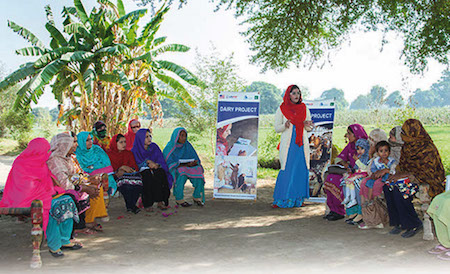
Community meeting with the female extension workers in a village
As I was working on the National Small and Medium Enterprise (SME) Policy of Pakistan, I realized that my academic background in business would not be enough to do justice with the task assigned to me. By 2004, I had already published an SME Issues paper and was working with at least four different task forces locking at different areas of policy including laws and regulation, SME definition, access to finance and availability of business development services specific to Small and Medium Enterprises. As the custodian of the SME Policy development, I was required to analyze data, stakeholders’ inputs, international best practices and local resource gap. It required a thorough understanding of public policy work hence I decided to join GRIPS for my second Masters in Public Policy, made possible thanks to the scholarship provided by the Asian Development Bank.
GRIPS equipped me with the right tools and understanding of public policy and related analytical work. During my stay at GRIPS, I was able to publish two academic research papers on Pakistani SME using the World Bank’s Investment Climate Assessment data. Dr. Wade Pfau was of enormous help and support, and these papers were presented in 2006, at the Donors Committee, Asia Regional Consultative Conference, Creating Better Business Environments for Enterprise Development, Bangkok. The work gave credence to my work, and paved the way for the passage of the National SME Policy in 2007.
While living in Japan, I learned the importance of interdependence, and of collective wisdom. Had I not been to GRIPS or Japan, I would have never learned it. It is the most valuable lesson that indeed helped me to advance my career to new heights.
Have you had any involvement, professional or otherwise, with Japan since your graduation?
After a gap of a decade, more recently, I have started working with Japanese manufacturers, and now representing UBE Corporation in Pakistan for marketing their products. Given more opportunities in near future, I would like to expand the product portfolio and scale of my involvement. I had an exploratory visit in 2019, and intend to visit Japan again to finalize more deals.
How do you maintain a balance between your work and the rest of your life? And what is your favorite thing to do when you are not working?
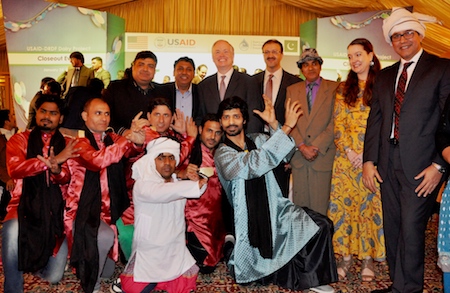
Sajjad with the street theatre team and the minister for agriculture
I love reading and traveling around the world. I have visited more than 20 countries in Asia, Africa, Europe and North America. I have perfected the art of cross-learning and hence do a lot of voluntary work for not-for-profit organizations.
I am part of the group that launched Pakistan’s first crowdfunding platform called “SeedOut” for providing interest free microfinance to microentrepreneurs. So far, we have helped over 1,000 entrepreneurs to get out of poverty and have a decent stable income stream for their families.
Through “Sun Shine Trust”, I have been instrumental in providing free school education to more than 750 out-of-school poor children. We don’t discriminate on race, color, religion or gender; 47% of children are girls and a good many of them are non-Muslims.
I am continuing the legacy of the “Dairy Project” and as a member of the Board of Directors of Dairy and Rural Development Foundation (DRDF) we still support small dairy farmers and still work with small farmers’ communities.
What are some of your fondest memories of your time spent at GRIPS? And what do you miss about Japan?
To be honest, Japan runs in my blood. I love Japanese culture, their reliance on each other, reliance on collective wisdom, and most importantly respect and honor that they give to each other. Japan has profoundly changed my philosophy about life, work and people. After visiting 20 countries, I realized that there is no other place like Japan, I really miss it.
If you could give one piece of advice to anyone considering studying at GRIPS what would it be?
Learn from each other while you are studying at GRIPS. The most valuable learning is going to come from the person sitting next to you or the person standing behind the podium (the lecturer). Second most important lesson will come from Japanese people, see and learn how to respect fellow citizens, and evolve a society that is prosperous, peaceful, takes pride in what they are, and heavily relies on partnerships and collective wisdom.
How would you like to maintain involved with the School? What do you expect from GRIPS as an alumnus and do you have any suggestions on how to further utilize the GRIPS alumni network?
It is my dream though if I could interact more often with students at GRIPS, and share my experiences in a more structured manner and on a regular basis. My interests at GRIPS are not the money or the position but to share and create knowledge that can help others to solve their specific policy issues.
I believe there is a galaxy of GRIPS alumni stars out there, who can help with their experiences and knowledge. We must have ways to engage them more. One option could be inviting ideas or experiences from them on most pressing policy issues. They can contribute case studies, talks, resource materials or even research.





